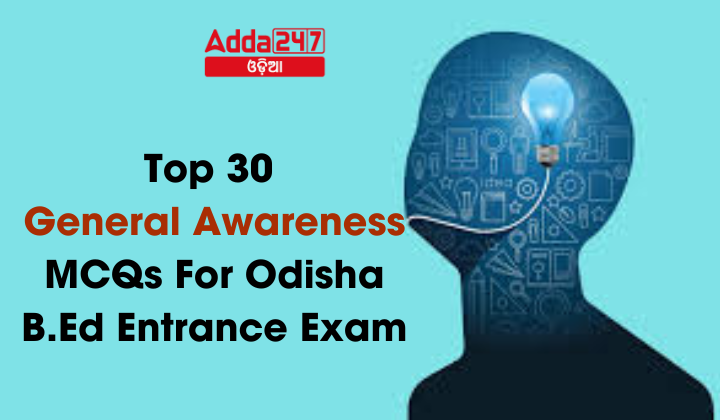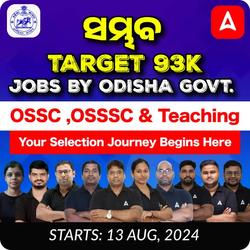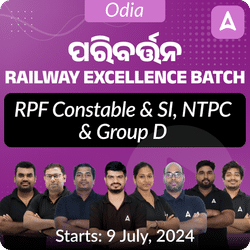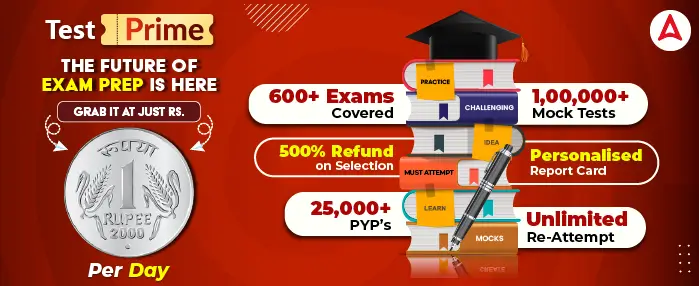Preparing for the Odisha B.Ed Entrance Exam requires a thorough understanding of education concepts and general awareness. Multiple-choice questions (MCQs) form a significant part of the exam. Here, we present the top 30 MCQs to help you ace your preparation.
Top 30 General Awareness MCQs For Odisha B.Ed Entrance Exam
- Who was the chairman of the University Education Commission (1948)?
(a) Dr. A. Lakshmanaswami Mudaliar
(b) D. S. Kothari
(c) Dr. S. Radhakrishnan
(d) Dr. A.P.J. Abdul Kalam
Ans. (c) Dr. S. Radhakrishnan - Which major focus area did the University Education Commission (1948) emphasize?
(a) Technical education
(b) Higher education as pivotal for national development
(c) Primary education
(d) Vocational training
Ans. (b) Higher education as pivotal for national development - Under whose chairmanship was the Secondary Education Commission formed in 1952?
(a) Dr. S. Radhakrishnan
(b) Dr. A.P.J. Abdul Kalam
(c) D. S. Kothari
(d) Dr. A. Lakshmanaswami Mudaliar
Ans. (d) Dr. A. Lakshmanaswami Mudaliar - Which key recommendation was made by the Secondary Education Commission (1952)?
(a) Establishment of multipurpose high schools
(b) Implementation of the Right to Education Act
(c) Introduction of the three language formula
(d) Emphasis on moral education
Ans. (a) Establishment of multipurpose high schools - What was the main aim of the Indian Education Commission (1964-66)?
(a) To promote women’s education
(b) To evolve a National System of Education
(c) To focus on technical education
(d) To implement the three language formula
Ans. (b) To evolve a National System of Education - How much did the Indian Education Commission (1964-66) recommend spending on education?
(a) 3 percent of the national income
(b) 5 percent of the national income
(c) 6 percent of the national income
(d) 10 percent of the national income
Ans. (c) 6 percent of the national income - What age range did the National Policy on Education (1968) emphasize for compulsory education?
(a) 3-6 years
(b) 6-10 years
(c) 6-14 years
(d) 8-16 years
Ans. (c) 6-14 years - Which formula did the National Policy on Education (1968) focus on for national integration?
(a) Two language formula
(b) Three language formula
(c) Four language formula
(d) One language formula
Ans. (b) Three language formula - What pattern does the NEP 2020 adopt for the school curriculum framework?
(a) 5-2-3-2 pattern
(b) 5-3-3-4 pattern
(c) 4-4-4-4 pattern
(d) 3-3-3-4 pattern
Ans. (b) 5-3-3-4 pattern - Which new body was proposed under the NEP 2020 for funding and capacity building in research?
(a) National Higher Education Regulatory Authority
(b) National Accreditation Council
(c) National Research Foundation
(d) Rashtriya Shiksha Aayog
Ans. (c) National Research Foundation - The Earth’s atmosphere is primarily composed of:
(a) Oxygen, nitrogen, and helium
(b) Nitrogen, oxygen, and argon
(c) Argon, carbon dioxide, and neon
(d) Helium, hydrogen, and ozone
Answer: (b) Nitrogen, oxygen, and argon - Why is oxygen essential for life?
(a) For photosynthesis
(b) For respiration in animals and plants
(c) For forming clouds
(d) For creating argon
Answer: (b) For respiration in animals and plants - Which of the following is a type of rock formed from cooling molten magma?
(a) Sedimentary rock
(b) Metamorphic rock
(c) Igneous rock
(d) Organic rock
Answer: (c) Igneous rock - A solar eclipse occurs:
(a) Only during a Full Moon
(b) Only during a New Moon
(c) When Earth blocks sunlight to the Moon
(d) When the Moon is furthest from Earth
Answer: (b) Only during a New Moon - The variation of day and night is due to:
(a) Earth’s axial tilt
(b) Earth’s orbit around the Sun
(c) Earth’s rotation
(d) Phases of the Moon
Answer: (c) Earth’s rotation - Which of the following is a primary energy source?
(a) Electricity
(b) Solar power
(c) Coal
(d) Nuclear fusion
Answer: (c) Coal - In photosynthesis, chlorophyll absorbs:
(a) Carbon dioxide
(b) Water
(c) Light
(d) Oxygen
Answer: (c) Light - Gravity is:
(a) The force of attraction between objects with mass
(b) The cause of magnetic fields
(c) Responsible for electrical conductivity
(d) A form of renewable energy
Answer: (a) The force of attraction between objects with mass - Materials that inhibit the flow of electric charge are called:
(a) Conductors
(b) Insulators
(c) Semiconductors
(d) Transformers
Answer: (b) Insulators - In the water cycle, what process changes water vapor back into liquid?
(a) Evaporation
(b) Condensation
(c) Precipitation
(d) Runoff
Answer: (b) Condensation - Which term is associated with Athletics?
(a) Free throw
(b) Pinching
(c) Relay
(d) Smash
Ans. (c) - Which term is not associated with Boxing?
(a) Knock out
(b) Upper-cut
(c) Smash
(d) Ring Stoppage
Ans. (c) - A Technical foul is associated with which sport?
(a) Baseball
(b) Badminton
(c) Basketball
(d) Boxing
Ans. (c) - Shuttlecock is associated with which sport?
(a) Basketball
(b) Badminton
(c) Baseball
(d) Boxing
Ans. (b) - A Homerun is a term from which sport?
(a) Basketball
(b) Baseball
(c) Boxing
(d) Badminton
Ans. (b) - Kalbeliya dance is performed by which community in Rajasthan?
(a) Rajputs
(b) Brahmins
(c) Snake charmers
(d) Traders
Ans. (c) - Which dance form from Uttar Pradesh is also prevalent in Uttarakhand?
(a) Raslila
(b) Giddha
(c) Jhora
(d) Dhamal
Ans. (c) - Phag Dance is celebrated during which occasion in Haryana?
(a) Harvest
(b) Diwali
(c) Holi
(d) New Year
Ans. (c) - Which dance form is performed predominantly by women in Punjab?
(a) Bhangra
(b) Giddha
(c) Nautanki
(d) Daph
Ans. (b) - Raslila is a traditional dance of which state?
(a) Punjab
(b) Uttar Pradesh
(c) Uttarakhand
(d) Rajasthan
Ans. (c)










